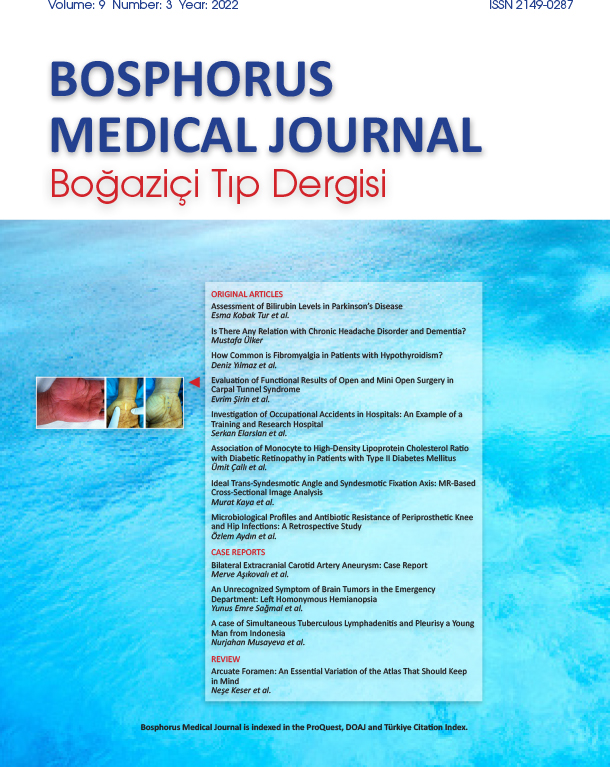Volume: 6 Issue: 3 - 2019
| ORIGINAL RESEARCH | |
| 1. | Evaluation of Consistency with Total Knee Arthroplasty Implants to Our Society With Three-Dimensional CT Ahmet Onur Akpolat, Sinan Karaca, Fatih Kılınç, Erkan Akgün, Nazım Karahan, Bekir Eray Kılınç doi: 10.14744/bmj.2019.86158 Pages 75 - 81 INTRODUCTION: Aim is to investigate the morphology of the knee of the people living in our country and to evaluate the harmony of the knee arthroplasty with their prosthetics, which are widely used in our country. METHODS: In this study, 200 patients, who had a CT taken for the angio of the lower extremity for various reasons, were included. Among 200 patients, 104 (52%) of them were male and 96 (48%) of them were female. Five different parameters from the proximal tibia and distal femur were used as evaluation criteria. After the measurements, the appropriate denture size for each denture brand was determined and the appropriate denture size and patient measurements were statistically evaluated. RESULTS: The femoral measurements of the patients and the femoral components of the prosthetics of the companies included in this study were not statistically compatible (p>0.05). Similarly, the tibia measurements and tibial components of the prosthetics of the companies included were not statistically compatible (p>0.05). DISCUSSION AND CONCLUSION: As a result of the metric evaluations, it was observed that there was no harmony between the size of knee prosthetic brands and the anthropometric values of living people in our country. |
| 2. | Effect of Spinal Growth Plate Reimplantation on Growth: Experimental Study in Lambs Ahmet Hamdi Akgülle, Erhan Okay, Reshad Zeynlaov, Onur Başçı, İlker Tinay, Evrim Şirin doi: 10.14744/bmj.2019.40469 Pages 82 - 88 INTRODUCTION: This study aims to evaluate the possibility of treating the defective segment without damaging the healthy adjacent vertebrae using growth plate transfer in segmentation defects. METHODS: In this study, a 6.5 mm diameter graft of intervertebral disc and growth plate between L3-4 vertebrae of six lambs were harvested and reimplanted to the same area. L2-L5 vertebrae were taken as a control group. Two months later, the growth of the reimplanted tissue underwent radiological and histological evaluation. RESULTS: Radiologically, comparison between study and control groups concerning bimonthly growth percentages (study: %5,467, control: %4,17) were found statistically significant [study group: %5,467, control group: %4,17; p=0.025, (p<0.05)]. Histologically, three vertebrae epiphyses were found to be near normal appearance, but in three vertebrae, severe fibrosis was seen. Proliferative zone thickening, which is evidence of epiphyseal ischemia, was not observed in any of the samples. Bone bridging of the physics was seen in only one sample. DISCUSSION AND CONCLUSION: Growth plate transfer in the treatment of congenital spinal deformity has found to be feasible technique, which provides a physiological vertebral growth. |
| 3. | Adult Vaccination Awareness in Physicians Gülden Yürüyen, İlkim Deniz Toprak, Yasin Kutlu doi: 10.14744/bmj.2019.25733 Pages 89 - 93 INTRODUCTION: When adult health is considered in our country and all over the world, preventive medicine applications, such as vaccination, remain important. With this study, we aimed to raise awareness about physician approaches and practices in adult vaccination. METHODS: For this study, the current literature on adult vaccination was examined, and an awareness questionnaire consisting of 22 multiple choice questions was prepared. After the approval of the local ethics committee, 200 physicians were asked questions. The responses were evaluated as a percentage according to the frequency calculation. RESULTS: According to the information obtained from the physicians, the Hepatitis B vaccine was the most common vaccine in adults. The rate of doctors recommending vaccination to their patients was 90%, which found to be quite high. Only 20% of the physicians were involved in vaccination-related training after graduation, and only 30% of them said they attach the necessary importance to adult vaccination in their daily practice. With a rate of 88.5%, most physicians wanted to have a practical reminder system. DISCUSSION AND CONCLUSION: When the accuracy of the theoretical information and answers were examined, that the findings suggest that the theoretical knowledge of physicians was sufficient. However, we should note that the current knowledge about vaccination applications and travel health should be updated in risky groups. |
| 4. | The Outcomes of Primary 23-gauge Vitrectomy in Retinal Detachment Patients with Grade C Proliferative Vitreoretinopathy Surgery Hatice Nur Tarakçıoğlu, Burcu Kemer Atik, Abdullah Özkaya doi: 10.14744/bmj.2019.39974 Pages 94 - 98 INTRODUCTION: To assess the outcomes of primary vitrectomy in retinal detachment (RD) patients with grade C proliferative vitreoretinopathy (PVR). METHODS: In this study, retrospective, single-surgeon case series were examined. The patients who had an RD with grade C PVR and underwent 23-gauge vitrectomy, and had a minimum follow up period of 12 months were included. The primary outcome measure of this study was the anatomical success (achievement of the totally attached retina) rate after a single surgery. RESULTS: A total number of 42 eyes of 42 patients were included in this study. The mean age was 57.6±13.9 years (range 27-88 years), and the mean follow-up was 17.1±4.8 months (range 12-22 months). The anatomical success rate after a single operation was achieved in 32 of the 42 patients (76.2%). The remaining 10 patients were operated again, and the final success rate increased to 95.2% (40 of the 42 patients). DISCUSSION AND CONCLUSION: The findings suggest that vitrectomy is effective in the treatment of RD with grade C PVR with satisfactory anatomical success. |
| CASE REPORT | |
| 5. | Silent Celiac Disease and Primary Biliary Cirrhosis Underlying Fibromyalgia: A Case Report Aliye Tosun, Sinan Akay, Ümit Seçil Demirdal, Zehra Akpınar, Korhan Barış Bayram, Semra Ergan, Ayhan Aşkın doi: 10.14744/bmj.2019.73645 Pages 99 - 102 Fibromyalgia syndrome (FMS) is characterized by chronic widespread musculoskeletal pain, stiffness and tenderness at multiple points. FMS can be classified as primary or secondary according to the presence of other medical disorders. Irritable bowel syndrome, a comorbid disorder frequently associated with FMS, has also been reported to be associated with celiac disease (CD) in which gluten triggers an autoimmune reaction in the small intestinal mucosa, which results in inflammation, villous atrophy, and malabsorption. Primary biliary cirrhosis (PBC) is the most common reported liver disease in CD. A gluten-free diet is the only effective treatment for CD and prevents the troublesome consequences of the disease. Herein, we present a fibromyalgic female patient in whom the diagnosis of CD and PBS were established upon investigating the causes of elevated liver biochemistry tests and iron-deficiency anemia. |
| 6. | Supraorbital Neuralgia: Case Report Hatice Ferhan Kömürcü, Eren Gözke doi: 10.14744/bmj.2019.62634 Pages 103 - 104 Supraorbital neuralgia (SON) is a rare type of neuralgia characterized by persistent pain over the supraorbital region and forehead along with shock like paresthesia in the distribution of the supraorbital nerve. SON is defined by the International Classification of Headache Disorder-2 by the following three criteria: 1) Pain on the supraorbital notch, forehead; 2) Tenderness in the supraorbital notch and in the area supplied by the supraorbital nerve; 3) Absolute-but transitory-relief of symptoms upon supraorbital nerve blockage. Sensory dysfunctions, such as hypoesthesia, paresthesia and allodynia and typical neuralgic features, may be present. Herein, we present a patient with supraorbital neuralgia who spontaneously resolved. |
| 7. | Superior Mesenteric and Splenic Vein Thromboembolism due to PAI-1 SERPINE 4, MTHFR 1298 CC and Factor II Prothrombin 2021GA Mutations: A Case Report Ahmet Can Sarı, Sönmez Ocak, Ömer Faruk Bük, Piltan Büyükkaya doi: 10.14744/bmj.2019.57070 Pages 105 - 107 Venous thromboembolism is known as a geriatric disorder, but sometimes, it can be seen in young adults. In these cases, the physician must consider genetic disorders for etiological factors, and genetic screening must be a part of the management plan. A previously healthy 34 years old man admitted to the emergency room with abdominal pain. After clinical and imaging evolution, a diagnosis of splenic infarct was made. After an uneventful splenectomy, the patient was re-admitted with severe abdominal pain and re-operated because of mesenteric ischemia. The genetic screening revealed PAI SERPINE 1 homozygous 4G/4G, MTHFR homozygous 1298 CC and factor II prothrombin 20210GA heterozygous mutations. |




















